RBSE Solutions for Class 8 Science Chapter 14 Refraction of Light are part of RBSE Solutions for Class 8 Science. Here we have given RBSE Rajasthan Board Solutions for Class 8 Science Chapter 14 Refraction of Light.
Rajasthan Board Solutions for Class 8 Science Chapter 14 Refraction of Light
| Board | RBSE |
| Class | Class 8 |
| Subject | Science |
| Chapter | Chapter 14 |
| Chapter Name | Refraction of Light |
| Number of Questions Solved | 52 |
| Category | RBSE Solutions |
Refraction of Light Textbook Questions Solved
I. Multiple Choice Questions
Question 1.
- Which of the following event is not related to refraction of light?
(a) The bottom of water filled bowl appears raised.
(b) Appearance of sun before sun rising and after sunset
(c) Formation of image by mirror
(d) Twinkling of stars - Which is not a part of a human eye?
(a) Retina
(b) Cornea
(c) Pupil
(d) Mid plane - When a ray of light enters into rarer medium from denser medium, it bends
(a) Away from normal
(b) Towards to normal
(c) Move in straight line without deviation.
(d) None of the above
Answers:
- (c)
- (d)
- (a)
Question 2.
Fill in the blanks
- ………………..of eye control the amount of light enter into eye.
- The image formation by…………………..the lens is always erect, virtual and small.
- Light ray enters into water medium from air bends…………………the normal.
Answers:
- Iris
- concave
- towards
Question 3.
Match Column A with column B
| Column-A | Column-B |
| 1. Liquid filled in between lens and cornea. | (a) Vitreous Humour |
| 2. Transparent liquid filled in between lens and retina. | (b) Iris |
| 3. Muscular structure of dark colour behind the cornea. | (c) Retina |
| 4. The portion of eye on which image is formed. | (d) Eye fluid. |
Answers:
- (d)
- (a)
- (b)
- (a)
Refraction of Light Short Answer Type Questions
Question 1.
What is refraction? What is the cause of refraction?
Answer:
When a light ray enters from one medium to another medium, then it deviates from its path. This phenomenon is called refraction of light.
Cause of Refraction: The speed of light in denser medium (glass) is less than rarer medium (air). Hence it is clear that when light enters in the denser medium from rarer medium its speed becomes slow, on the other hand when it enters from denser to the rarer medium, it’s speed increases. Hence phenomenon of refraction takes place due to difference in speed of travelling from one medium to another.
Question 2.
Write the main difference between convex and concave lens.
Answer:
A lens which is thick in middle portion and thin at the edges, is called convex lens. This lens converts all the beams of parallel rays of light into a single point, hence it is called a convex lens. The beams of light rays coming parallel to the axis refract from a convex lens and the point where they all are converge is called focal point of the lens, A lens which is thick at the edges and thin in middle portion is called a concave lens. This lens diverge the light beam coming parallel to the axis. Hence it is called concave lens. Light rays passing through lens deviate from their path, hence we can say that lens refract the light rays,
Question 3.
Define the refraction coefficient.
Answer:
Refraction Coefficient is the proportion of speed of light in two mediums. It is constant and dimensionless quantity.

Question 4.
What do you mean by dispersion? Write the sequence of colours in rainbow.
Answer:
The phenomenon due to which all the seven colours of white light separate and form a band of seven colours is called dispersion of light. This occurs because speed of all colours are different in glass prism. Hence when white beam of light enters the prism, it splits into its original colours violet, indigo, blue, green, yellow, orange and red colour. This is called dispersion of light.
Question 5.
The two classmates of Meena are Raghav and Megha, Raghav is not able to see distant objects and Megha is not able to see near objects. What are eye’s defects they have? To remove these defects which type of lens they should use in their spectacles?
Answer:
Raghav is suffering from far sightedness or hypermetropia. It is corrected by using convex lens. Megha is suffering from shortsightedness or myopia. It is corrected by using concave lens.
Refraction of Light Long Answer Type Questions
Question 1.
Explain the refraction of light rays from glass slab with a pictorial diagram.
Answer:
Fix a white paper sheet on a drawing board with the help of drawing pins. On paper keep a rectangular glass slab in centre. Draw7 sketch of a slab with pencil name this figure as PQRS. Remove slab and draw a normal at MON point O, MON also make an angle of incidence AO (30°) wdth the help of a protector and draw a line AB, on this line at point A and B, stick two pins vertically. Now put again glass slab on the same sketch on opposite side. Look the images of pins and point A and B. Rat a pin at point C in such a way that point C and images of point A and B should be in a straight line. Take one more pin and put in such a way that Point A,B,C and D look in a straight line, remove pins and slab.
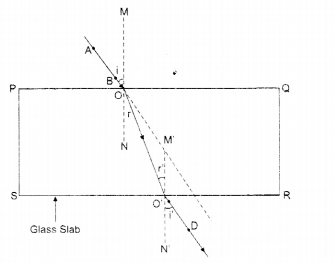
Where pins C & D were put. Encircle them and draw a line between them join it width O’. Draw normal O’N’ at point O’ on the surface SR. Now, join O with O’ and extend AB also we see that line in the direction of A, B blow’s into the air and light ray strikes the surface of the slab and enters it. On point O it bends towards normal, while enters from a rarer medium to denser medium, (i.e. air to glass). In the same manner when it travels from denser to the rarer medium {i.e. glass to air) on surface SR point O’ it goes away from the normal.
So we can say that:
- When light ray enters from rarer to the denser medium (air to glass) it bends towards normal.
- When light ray enters from denser to the rarer medium (i.e. glass to air) it goes away from the normal.
Question 2.
Name the optical instruments which use lens. Describe it in brief.
Answer:
In correction of defects of vision-In spectacles both types of lenses are used. Those who cannot see things at distance clearly, they suffer from defect of near sightedness. Such people use concave lenses. Those who cannot see things nearby, they suffer from defect of far sightedness. They use convex lens. Simple microscope – Clock repairers use a convex lens to see the very small parts of clock. This single convex lens is called simple microscope. In this microscope the low focal length lens is used. By this small things can be magnified. Compound microscope – In this microscope two convex lenses are fitted in a metal tube. Lens is located on the side where object is kept, is called objective lens while lens which is kept near eye is called eye piece. Telescope – It is used to see things at very far distance. It also contains two convex lenses. They are also called objective lens and eye piece.
Question 3.
Explain in brief the working and structure by human eye.
Answer:
In our eyes there is convex lens located which is formed by flexible muscles. Due to this lens, image of object formed at retina, and we can see things. Our eyes are round in shape, the outermost conversing of eye is white in front of it, transparent part cornea is situated, behind cornea dark coloured structure made of muscles is located, it is called iris. There is a small hole in iris called Pupil. Its size is controlled by the iris. In the case of more light the aperture of pupil reduces and in low light it increases. At the back of the pupil is eye lens which is located at its place with the help of muscles. The part between cornea and lens is filled with transparent fluid which is called eye fluid or Aqueous humour.
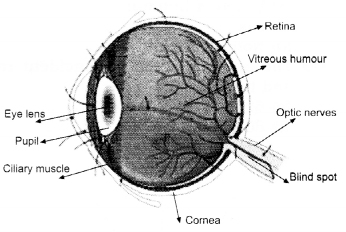
Through lens inverted image is formed on retina. Retina is a light absorber transparent membrane which has many light sensitive nerves, these are connected to brain. When these nerves send the message of the formation of image on retina to the brain, then brain converts inverted image into erect image and we see the object. The transparent fluid fill between lens and retina is called vitreous humour or fluid.
Refraction of Light Additional Questions Solved
I. Multiple Choice Questions
Question 1 .
The process of bending light into seven colours is called
(a) Deflection
(b) Dispersion
(c) Spectrum
(d) Normal
Question 2.
The amount of light entering the eye is controlled by
(a) Iris
(b) Ciliary muscle
(c) Cornea
(d) Eye lens
Question 3.
In cataract, the lens of the eye becomes
(a) Clear
(b) small
(c) Large
(d) opaque
Question 4.
At what position of the object does a convex lens act as a magnifying glass?
(a) between F and 2F
(b) between F and O
(c) Beyond F
(d) Beyond 2F
Question 5.
The image which cannot be obtained on screen is called
(a) Erect
(b) Real
(c) Virtual
(d) Inverted
Question 6.
We are able to see objects around us because
(a) The objects absorb all the light
(b) The light can be reflected
(c) Light travels in straight line
(d) The light reflected from the object enters our eyes.
Question 7.
In whose memory National Science Day is celebrated
(a) Dr.CV Raman
(b) Dr.Chandra Shekhar Bose
(c) Dr.Homi Jahangir Bhabha
(d) None of these
Question 8.
The liquid filled between the retina and the lens is called
(a) Eye fluid
(b) Vitreous humour
(c) Iris
(d) None of these
Question 9.
The angle between the incident ray and the reflected ray is
(a) 60°
(b) 90°
(c) 80°
(d) 40°
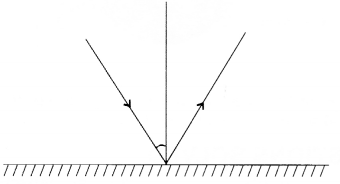
Question 10.
When a ray of light passes through the second optical medium with a change in the angle, the phenomenon is known as
(a) Reflection of light
(b) Absorption of light
(c) Refraction of light
(d) None of these
Question 11 .
The band of seven colours that constitute white light is known as
(a) Rainbow
(b) Palette
(c) Spectrum
(d) None of these
Question 12.
What is located just below the macula?
(a) Blind spot
(b) Yellow spot
(c) both (a) and (b)
(d) None of these
Question 13.
Which of the following is used as a side view mirror?
(a) Plane mirror
(b) Convex mirror
(c) Concave mirror
(d) None of these
Question 14.
When an object is placed between focus and optical center of convex lens then the image so formed is
(a) Real and inverted
(b) Real and erect
(c) Erect, virtual and smaller in size
(d) Erect, virtual and magnified
Question 15.
When object lies at 2f in front of a convex lens, its image distance from the lens is at
(a) f
(b) Infinity
(c) Between 2f and infinity
(d) 2f
Answers:
1. (b)
2. (a)
3. (b)
4. (b)
5. (c)
6. (d)
7. (a)
8. (b)
9. (c)
10. (c)
11. (c)
12. (a)
13. (b)
14. (d)
15. (d)
II . Write true or false in front i of the statements given below:
- Iris in the human eye controls the light entering it. (True/False)
- Concave lens is known as convergent lens. (True/False)
- Optic nerve sends messages to the brain. (True/False)
- Virtual image cannot be formed on a screen. (True/False)
- A concave lens always formed a virtual, erect and diminished image. (True/ False)
- Real images are always inverted. (True/False)
- Small hole in Iris is called pupil. (True /False)
- Shortsightness eye defect persons cannot see nearby objects. (True/False)
- The high focal length convex lens is used in simple microscope. (True /False)
- Dr. C.V. Raman was awarded the Bharat Ratna by the Government of India in 1954. (True/False)
Answers:
1. (T)
2. (F)
3. (F)
4. (T)
5. (T)
6. (T)
7. (T)
8. (F)
9. (F)
10. (T)
III. Match Column A and B
| Column-A | Column-B |
| (i) A defect in the eye when a person can see nearer objects but not far off objects. | (a) Blind Spot |
| (ii) The phenomenon of splitting of white light | (b) Braille |
| (iii) A jelly like fluid found in the posterior part of the eye. | (c) Vitreous Humour |
| (iv) A special script designed for Visually challenged people for reading | (d) Myopia |
| (v) It is a region on the retina where the optic nerve enters the eye ball. | (e) Dispersion |
Answers:
(i) ↔ (d)
(ii) ↔ (e)
(iii) ↔ (c)
(iv) ↔ (b)
(v) ↔ (a)
Refraction of Light Very Short Answer Type Questions
Question 1.
What is light?
Answer:
Light is a source of energy which enable us to see through our eyes.
Question 2.
What is dispersion?
Answer:
The phenomenon due to which white light splits into seven colors (VIBGYOR) when passed through an equilateral prism is called dispersion.
Question 3.
What is refractive index?
Answer:
The ratio of speed of light in air to speed of light in medium is called refractive index of that medium.
Question 4.
What is Hypermetropia? How is hypermetropia corrected?
Answer:
People who cannot see nearby object very clearly but can see far objects clearly and is said to have a defect called hypermetropia. This defect is corrected by wearing spectacles made of convex lenses.
Question 5.
What is lens? How many types of lens are there?
Answer:
The transparent medium covered by the two curved surfaces is called lens. There are mainly two types of lens:
- Convex (converging lens)
- Concave (Diverging lens)
Question 6.
Why is convex lens called converging lens?
Answer:
When the rays of light coming parallel to principle axis after refraction through the lens passes through a point called focus, since it converge all the ray at one point, that is why it is said to be converging lens.
Question 7.
Define the following terms:
- Principal axis
- Optical center
- Focus
- Focal length
Answer:
- Principal axis: The line passing through the centers of the curvature (C1) and C2 is called principal axis,
- Optical center: The point on the principle axis inside lens, through which a light ray passes without any deviation is called optical center(O) of the lens.
- Focus: The ray of light coming parallel to principle axis after refraction through the lens meet a point known as focus, it is denoted by the letter F.
- Focal length: The distance between the focus and the optical center is known as focal length. It is denoted by f. Focal length is equal to half the radius of the curvature i.e f = r/2.
Question 8.
What type of image is formed by concave lens?
Answer:
Concave lens always form virtual, erect and diminished image.
Question 9.
What type of image is formed at retina?
Answer:
Inverted image is formed at retina.
Question 10.
What is blind spot?
Answer:
The point where the optic nerve enters the eye has which no nerve endings. It is insensitive to light and is called blind spot.
Question 11.
When an object is placed within the focal length of the convex lens, where does its ‘image will form?
Answer:
When an object is placed within the focal length of a convex lens a virtual, erect and magnified image is formed.
Question 12.
What is the cause of refraction?
Answer:
The refraction of light is due to the change in the speed of light on going from one medium to another.
Question 13.
Write atleast three effects of refraction of light in our day to day life?
Answer:
The refraction of light produces many effects which can be easily observed in our day to day life. Those are:
- An object placed under water appears to be raised.
- A pool of water appears to be less deep than it actually is.
- The stars appear twinkle on a clear night.
- A stick held obliquely and partly immersed in water appears to be bent at the water surface.
Question 14.
A ray of light goes from a denser medium to a rarer medium, will it bend towards the normal or away from the normal?
Answer:
When a ray of light goes from a denser medium to a rarer medium, it will move away from the normal, due to the fact that when the ray of light travelling from denser to rarer its speed increases and it appears to move away from the normal.
Question 15.
Give two uses of convex lens.
Answer:
- Convex lens is used as magnifying glass.
- Convex lens are used in spectacles to correct the defect of vision called hypermetropia.
Refraction of Light Short Answer Type Questions
Question 1.
Draw a ray diagram, for the image formation of an object when it is placed at
- F
- In between F and O. Write its nature of the image.
Answer:
- When an object is placed at F: The image will formed at infinity, magnified real and inverted.
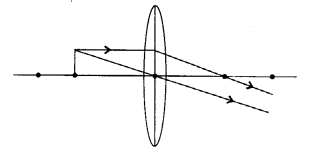
- When object is in between F and O. The image will formed on the same side of the object, erect, virtual and larger than the size of the object.
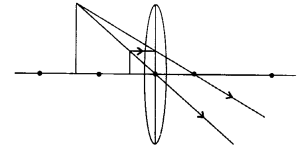
Question 2.
Define cataract.
Answer:
Another defect of eye which usually comes in old age is called cataract. The medical condition in which the lens of the eye of a person becomes progressively cloudy resulting in blurred vision is called cataract. Cataract decreases the vision of eye gradually. It can ever lead to total loss of the vision of eyes. The vision of the person can be restored after getting surgery done on the eye having cataract.
Question 3.
Write a short note on Dr. C.V. Raman.
Answer:
He was an Indian Physicist. He was honoured with prestigious Nobel Price in Physics in 1930 for his excellent work on scattering of light. The discovery made by him on scattering of light is known as Raman effect. He was awarded the Bharat Ratna in 1954 and Lenin peace Prize in 1957. In his memory National Science Day is celebrated every year in India.
Question 4.
Why is pencil immersed under water appears to be bent?
Answer:
The pencil immersed under water appears to be bent due to refraction of light. The rays of light from dipped part of pencil get refracted away from the normal due to refraction.
Question 5.
Why is concave lens called diverging lens?
Answer:
When the ray of light coming parallel to principle axis after refraction through the concave lens diverges and when we produced these rays backward they appears to meet at a point called focus, since lens diverges the ray of light that is why it is called diverging lens.
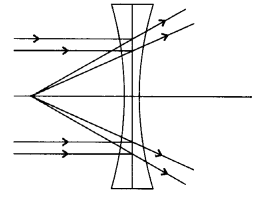
Question 6.
Why are stars twinkling in night?
Answer:
The layers of atmosphere have different densities so have different coefficients of refraction. The light coming from stars deviates continuously after passing through these different atmospheric layers. That is why the stars seem twinkling in night.
Question 7.
Draw a ray diagram, when the object is placed between F and 2F. Write the nature of the image so formed.
Answer:
When the object is placed in between F and 2F the image is formed beyond 2F, real, inverted and larger in size.
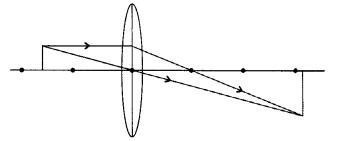
Question 8.
What are the functions of Iris and Pupil in human Eye?
Answer:
The Iris controls the amount of light entering the eyes. The Iris automatically adjusts the size of the pupil according to the intensity of light received by the eye. If the amount of light received by the eye is larger, then the iris contracts the pupil and reduces the amount of light entering the eye. On the other hand if the amount of light received by the eye is small the iris expands the pupil so that more light may enter into the eyes.
Question 9.
What are the causes for short sightedness?
Answer:
The causes of short sightedness are:
- Due to high converging power of eye lens because of its short focal length.
- Due to eye ball being too long.
We hope the given RBSE Solutions for Class 8 Science Chapter 14 Refraction of Light will help you. If you have any query regarding RBSE Rajasthan Board Solutions for Class 8 Science Chapter 14 Refraction of Light, drop a comment below and we will get back to you at the earliest.